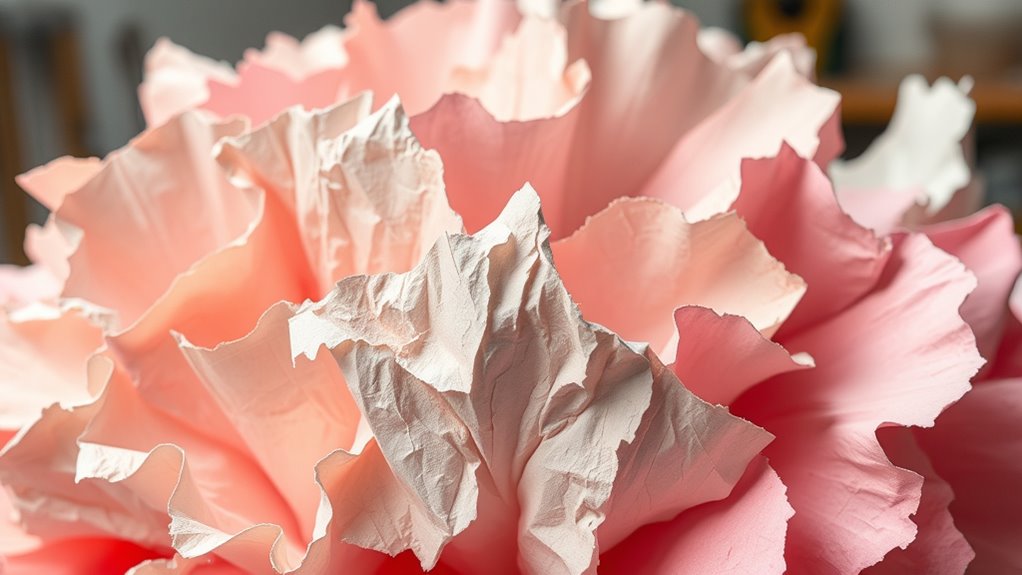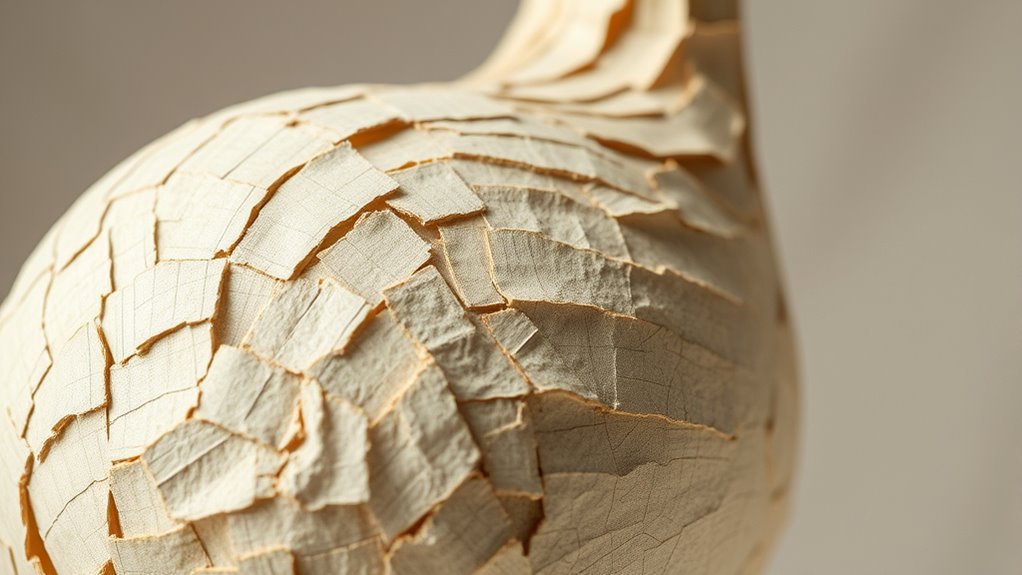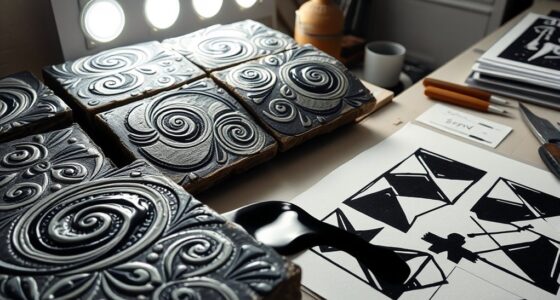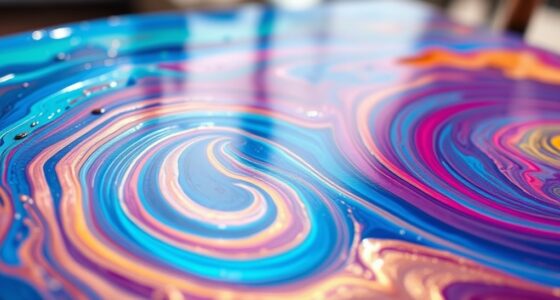To build forms with paper for papier-mâché sculptures, start by shaping wire or crumpled paper into your desired outline. Cover the form with torn strips of paper dipped in a glue mixture, layering carefully to create strength and detail. Once dry, you can smooth and refine the surface, then paint or decorate as you like. By exploring these techniques further, you’ll discover how versatile and creative your papier-mâché projects can become.
Key Takeaways
- Build a strong armature using wire or cardboard as a base for shaping your sculpture.
- Tear paper into strips and coat them with adhesive or glue to layer onto the armature.
- Apply multiple layers of paper strips, allowing each layer to dry for a sturdy, lightweight form.
- Sculpt details by adding more paper layers or shaping wet paper into desired forms.
- Finish by painting or decorating your sculpture to enhance surface texture and visual appeal.

Papier-mâché sculpture is a versatile and accessible art form that allows you to create detailed, lightweight sculptures using simple materials. Its flexibility makes it suitable for both beginners and seasoned artists, offering endless possibilities for expression. When diving into papier-mâché, you’ll quickly discover that incorporating mixed media techniques can elevate your work. Combining paper with paints, textiles, or found objects adds texture and depth, transforming a basic form into a unique masterpiece. This approach encourages experimentation, letting you push the boundaries of traditional sculpture by blending different materials seamlessly.
Papier-mâché offers endless creative potential through mixed media techniques and lightweight, accessible materials.
Understanding the historical origins of papier-mâché enriches your appreciation for this craft. Its roots trace back thousands of years to ancient China, where artisans used paper and glue to craft masks, decorative objects, and even armor. From there, the technique spread across Asia and eventually reached Europe via trade routes. In medieval Europe, papier-mâché was popular for creating ornate religious statues and theatrical props because of its affordability and ease of shaping. During the Renaissance, artisans refined the process, combining it with gilding and painting to produce intricate decorative pieces. In the 19th and 20th centuries, papier-mâché gained prominence in the sphere of folk art and modern sculpture, thanks to its lightweight nature and affordability, making it accessible for community projects and educational settings.
As you explore building forms with paper, you’ll notice that the historical significance of papier-mâché influences contemporary practices. Artists today often draw inspiration from traditional methods, while also incorporating modern mixed media techniques for innovative results. Whether you’re crafting a mask, sculpture, or decorative object, understanding its lineage helps you appreciate the craftsmanship behind each piece. You’ll find that the process involves layering strips of paper coated with adhesive, shaping the material into your desired form, and then refining it with paint or other media. The lightweight aspect makes it easy to handle, transport, and display your work, which is especially helpful if you’re creating large or complex sculptures.
In essence, embracing the historical origins and mixed media techniques of papier-mâché allows you to connect with a rich tradition of craftsmanship while adding your personal touch. This art form not only encourages creativity but also provides a practical way to produce durable, eye-catching sculptures with everyday materials. So, gather your paper, glue, and tools, and start building forms that reflect your imagination and respect for this ancient yet ever-evolving craft.
Frequently Asked Questions
How Long Does a Papier-Mâché Sculpture Typically Last?
A papier-mâché sculpture typically lasts several years, depending on durability factors like the type of paper, adhesive, and environmental conditions. To guarantee it stays intact longer, you should use preservation techniques such as sealing with varnish or acrylic paint. Keep your sculpture away from moisture, direct sunlight, and extreme temperatures. With proper care, your papier-mâché creation can remain vibrant and stable for many years.
Can Papier-Mâché Sculptures Be Painted or Decorated After Drying?
Yes, you can paint or decorate your dried papier-mâché sculpture. Imagine brushing vibrant colors onto its textured surface, transforming it into a lively work of art. Use different painting techniques like dry brushing or washes to add depth and character. For decorative finishes, try sealing with varnish or adding embellishments—these steps will enhance its appearance and durability, making your sculpture truly stand out and last longer.
What Are Common Mistakes to Avoid During the Building Process?
To avoid common mistakes, you should make certain your papier-mâché structure isn’t too fragile by applying multiple thin layers rather than one thick coat. Watch out for uneven coating, which can cause weak spots or cracks. Avoid rushing the drying process, as it weakens the sculpture. Handling it gently during building and drying helps prevent breaking. Keep these tips in mind to create a sturdy, well-shaped papier-mâché piece.
Is Papier-Mâché Suitable for Outdoor Sculptures?
Yes, papier-mâché can be suitable for outdoor sculptures if you focus on weather resistance and material durability. You should seal your sculpture thoroughly with waterproof coatings, apply multiple layers of protective sealant, and choose sturdy, weather-resistant paper. These steps help prevent damage from rain, sun, and wind. With proper sealing and maintenance, your papier-mâché sculpture can withstand outdoor conditions and remain beautiful over time.
How Do You Repair Damaged or Broken Papier-Mâché Art?
When repairing damaged papier-mâché art, you should start by cleaning the broken area. Use appropriate restoration techniques like applying a strong adhesive, such as PVA glue or a glue gun, to reattach broken pieces. For larger cracks or missing sections, reinforce the repair with strips of paper dipped in adhesive. Carefully smooth the surface, then let it dry thoroughly to restore your artwork’s integrity and appearance.
Conclusion
Don’t worry if your sculpture isn’t perfect—papier-mâché is forgiving and easy to fix. With patience, you’ll see your creative vision come to life, even if it’s a little rough around the edges. Remember, every masterpiece starts with simple layers of paper and glue. So, embrace the process and enjoy shaping your ideas. In the end, your unique sculpture will be a proud reflection of your imagination and effort.









